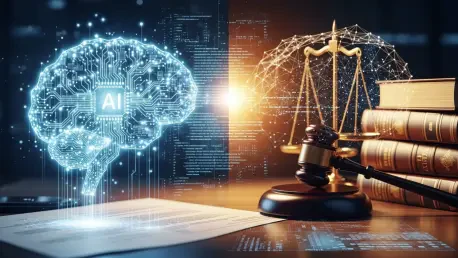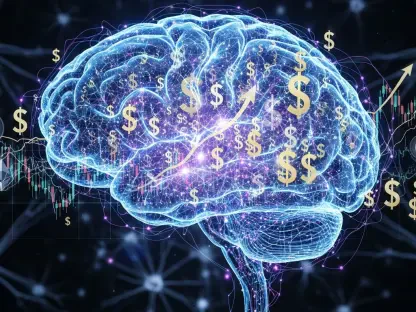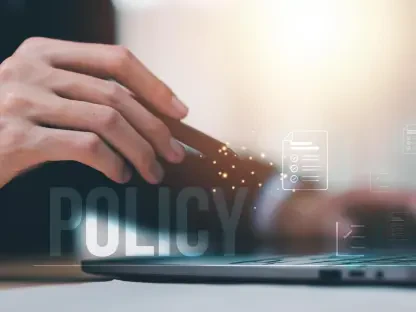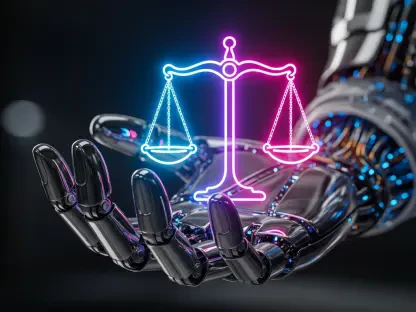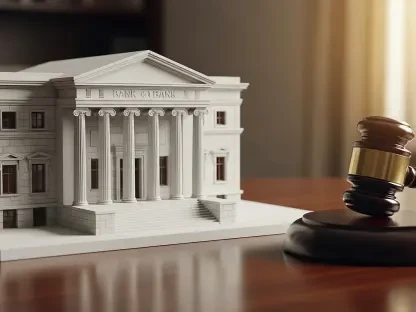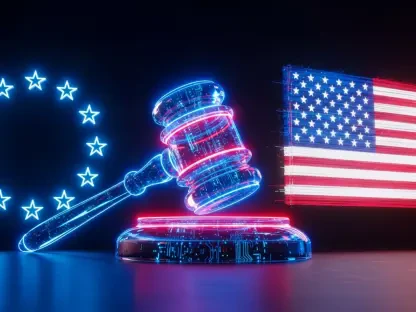Setting the Stage for a Legal Revolution in AI and IP
In an era where artificial intelligence (AI) generates everything from intricate artwork to groundbreaking inventions, a staggering statistic emerges: global spending on AI is projected to reach $632 billion by 2028, reflecting an unprecedented integration into industries worldwide. This rapid ascent of AI, particularly generative AI (GenAI), has transformed how businesses operate, slashing production times and fueling creative output at a scale never seen before. Yet, beneath this technological marvel lies a profound legal conundrum: how can intellectual property (IP) laws, crafted for human ingenuity, accommodate creations born from algorithms? This clash between innovation and tradition poses critical questions about protection, ownership, and liability, setting the stage for a pivotal debate in legal and industrial circles. As AI reshapes the landscape, the urgency to adapt IP frameworks becomes not just a challenge, but a necessity to sustain progress and fairness.
Understanding the Intersection of AI and Intellectual Property
The relationship between AI technologies and IP laws is evolving at a breakneck pace, driven by the ability of AI systems to autonomously produce content that rivals human output. Generative AI, capable of crafting text, images, and even music, has become a cornerstone of industries ranging from entertainment to engineering, streamlining processes and unlocking new creative frontiers. Its significance lies in the sheer efficiency it offers, often reducing tasks that once took weeks into mere minutes, thereby redefining productivity standards across sectors.
Current adoption rates underscore AI’s pervasive influence, with 65% of organizations reportedly leveraging GenAI tools as of recent industry surveys. Projections indicate that investment in AI will continue to soar, reflecting confidence in its potential to drive economic growth. These figures highlight a global embrace of AI, positioning it as a critical component of modern business strategies and a catalyst for innovation on a massive scale.
At the heart of this transformation lies a fundamental conflict: traditional IP frameworks, built on the premise of human creativity, struggle to address the autonomous capabilities of AI. Copyright and patent laws were designed to reward individual effort and originality, yet AI systems operate without personal intent or consciousness, challenging the very definitions of authorship and inventorship. This discord raises essential questions about how to protect AI-generated works and who, if anyone, should claim rights over them, setting the stage for a legal paradigm shift.
Key Issues in IP Protection for AI Creations
Human Involvement as a Determinant for Protection
Central to the debate over IP protection for AI creations is the requirement of human agency, a cornerstone of existing patent and copyright systems. Patent laws globally stipulate that an inventor must be a natural person, a principle upheld in cases like the rejection of applications listing the AI system DABUS as the inventor by entities such as the European Patent Office. This stance reflects a deep-rooted belief that invention is inherently tied to human intellect, rendering AI ineligible for recognition as a creator under current legal standards.
In copyright law, the emphasis on human authorship further complicates matters, as protection often hinges on an individual’s lifespan plus additional years—a model incompatible with AI’s timeless operation. Decisions vary widely across jurisdictions; for instance, the U.S. Copyright Office has denied registration for fully AI-generated works, citing insufficient human input, while China’s Beijing Internet Court granted copyright to an image produced by Stable Diffusion, recognizing the human effort in designing prompts. Such disparities reveal the inconsistent application of IP principles to AI outputs.
A critical distinction arises between AI-assisted content, where humans guide the creative process, and AI-generated content, produced with minimal human intervention. The former typically qualifies for protection due to evident human involvement, akin to using software tools, whereas the latter often falls into a legal gray area. This differentiation underscores the need for clearer guidelines to address the spectrum of AI’s role in creation, ensuring that IP laws remain relevant in an increasingly automated world.
Ownership Disputes and Legal Ambiguities
Determining ownership of IP rights in AI-generated content presents another layer of complexity, as AI itself lacks legal personality and cannot hold rights. Stakeholders such as AI system owners, developers, trainers, and end users all have potential claims, leading to heated debates over entitlement. Contractual terms, like those from OpenAI assigning rights to users for outputs from platforms like ChatGPT, attempt to provide clarity, yet they often vary by provider and context, adding to the confusion.
Legislative responses offer some direction, with jurisdictions like the United Kingdom assigning copyright for computer-generated works to the person facilitating the creation under specific statutes. Ukraine has taken a progressive step by amending laws to grant special rights over non-original AI content to software licensees or owners, signaling an intent to adapt to technological realities. However, these solutions are far from universal, leaving many regions without definitive rules on ownership allocation.
An alternative perspective suggests placing AI-generated content in the public domain, as advocated by certain U.S. guidelines that deny copyright to works lacking human authorship. This approach aims to prevent perpetual protection and ensure broad access, yet it clashes with arguments for rewarding human stakeholders who enable AI outputs. Balancing these competing views remains a significant hurdle, necessitating innovative legal frameworks to resolve ownership ambiguities without stifling AI’s potential.
Challenges of IP Infringement in the AI Ecosystem
The risk of IP infringement looms large in the AI ecosystem, particularly during the training and output phases of generative systems. AI models often rely on vast datasets scraped from public sources, which may include copyrighted material used without explicit permission. In regions lacking exceptions for data mining or research, this practice can constitute infringement, exposing developers to legal challenges and financial penalties.
High-profile litigation, such as Getty Images v. Stability AI, illustrates the tangible consequences of these risks, with lawsuits targeting AI providers for allegedly using protected content in training models. Such cases highlight the broader implications for users and developers alike, as outputs resembling existing works can trigger claims of copying, especially when data sources are limited. The legal scrutiny of AI-generated content is intensifying, placing pressure on companies to ensure compliance with IP standards.
Liability extends across the AI supply chain, potentially implicating developers, corporate deployers, and individual users depending on jurisdiction and specific actions. Mitigation strategies are becoming essential, including fine-tuning AI systems to minimize replication of protected works, implementing plagiarism detection tools, and securing contractual indemnities from providers. These measures, alongside employee training to avoid risky inputs, represent practical steps to navigate the complex terrain of IP infringement in AI deployment.
Regulatory Landscape and Emerging Legal Frameworks
The current regulatory environment for AI and IP remains predominantly human-centric, with most laws unprepared to address the nuances of autonomous creation. Copyright and patent systems worldwide prioritize human involvement, often leaving AI-generated works outside the scope of protection unless tied to a natural person. This traditional approach creates gaps in legal coverage, as AI’s role in innovation continues to expand beyond mere assistance.
Certain jurisdictions are pioneering adaptations to bridge these gaps, with the UK’s provision for computer-generated works assigning rights to human facilitators serving as a notable example. Ukraine’s recent legislative updates offer another model, establishing tailored rights for AI-related content to ensure clarity for software stakeholders. These efforts, while promising, are isolated, revealing a lack of cohesive global standards that hinders legal certainty in cross-border AI development.
The absence of international harmonization exacerbates challenges, as differing rules across regions create unpredictability for multinational entities leveraging AI technologies. Without unified guidelines, businesses face varying compliance burdens, potentially slowing innovation or leading to jurisdictional conflicts. Addressing this fragmentation will require collaborative efforts among policymakers to align IP laws with the borderless nature of AI, fostering an environment conducive to technological advancement.
Future Directions for AI and IP Law Integration
Looking ahead, IP laws are poised to undergo significant evolution to keep pace with AI’s relentless progress, potentially introducing sui generis rights specifically for AI creations. Such bespoke frameworks could offer a middle ground, recognizing the unique nature of algorithmic output without undermining the human-centric ethos of IP protection. This shift may redefine how innovation is incentivized in an era dominated by machine-driven content.
Emerging trends point to heightened judicial and regulatory focus on AI training data and outputs, with courts likely to scrutinize the origins of datasets more rigorously in coming years. This scrutiny could lead to stricter requirements for transparency in data usage, compelling AI providers to adopt ethical sourcing practices. Additionally, evolving case law will shape how outputs are evaluated for originality, influencing the balance between protection and public access.
Broader forces, including global economic conditions, technological breakthroughs, and shifting consumer expectations, will also mold future IP policies. Economic pressures may push for policies that prioritize innovation over stringent protection, while consumer demand for AI-driven content could accelerate legal reforms. As these dynamics interplay, the trajectory of AI and IP integration will hinge on adaptability, ensuring that legal systems support rather than hinder technological growth.
Reflecting on Insights and Charting the Path Forward
The exploration of AI’s intersection with IP laws reveals a landscape fraught with tension yet ripe with potential, as stakeholders grapple with adapting human-centric frameworks to autonomous creations. Challenges around protection eligibility, ownership disputes, and infringement risks dominate discussions, underscoring the urgency of legal evolution. The varied approaches across jurisdictions paint a picture of innovation outpacing regulation, with pioneering efforts in some regions offering glimpses of possible solutions.
Moving forward, stakeholders need to prioritize proactive engagement with emerging legal developments, advocating for harmonized global standards to reduce uncertainty. Implementing robust risk mitigation strategies, from technological safeguards to contractual protections, emerges as a critical step to navigate infringement pitfalls. Collaboration between industry leaders and policymakers stands out as essential to crafting balanced laws that safeguard IP principles while unleashing AI’s transformative power, ensuring a future where innovation and fairness coexist seamlessly.
